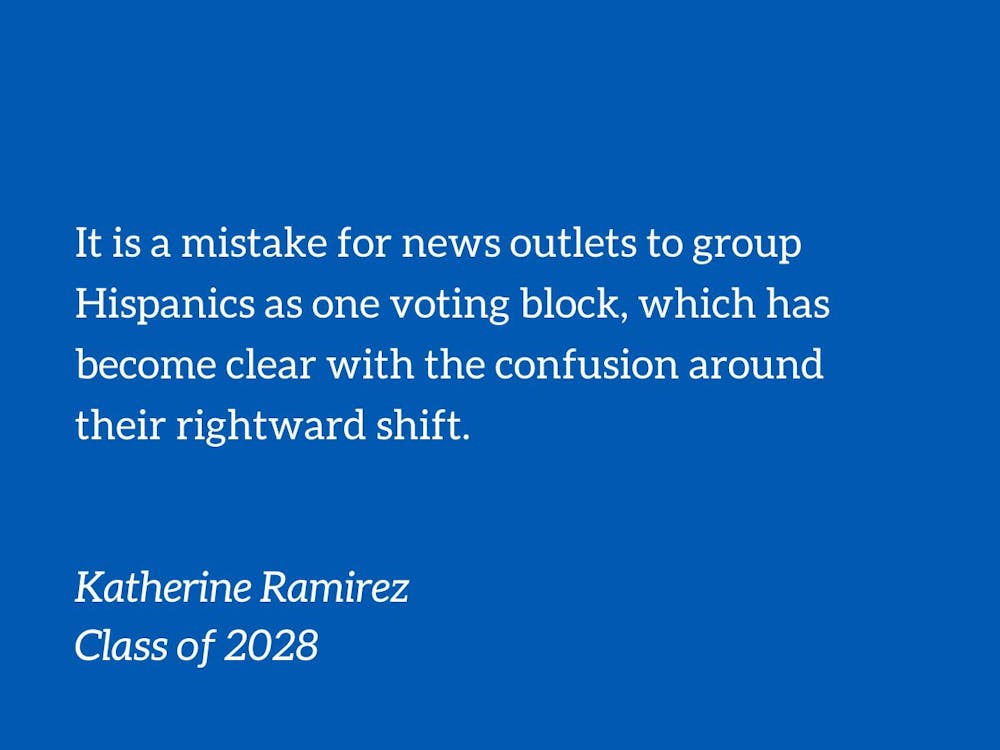As the Hispanic vote becomes less blue each election cycle, news outlets continue to wonder why. In 2016 Democrats won 65% of the Hispanic vote, and in 2020 this percentage lowered to 62%. But a recent poll in the New York Times estimates that only 52% of Hispanic voters will go for Harris while 40% will vote Trump. Some polls look better for Democrats on the Hispanic vote, but the days of over 60% margins towards Democrats are over. This trend has progressed since the Obama administration ended and has only accelerated in recent years. But when analyzing such trends, many have failed to break down the changing Hispanic vote.
When understanding the Hispanic vote, it is important to break down the regional prevalence of different Hispanic origins. According to The Washington Post, western states getting attention in the election such as Nevada and Arizona have largely Mexican diasporas. North Carolina also follows with a significant Mexican population despite its location on the East Coast. In the Northeast and Central Florida there are large Puerto Rican populations, while South Florida has large Cuban and Venezuelan populations.
These demographics have large differences in their voter profiles. Mexican voters lean heavily Democrat with attacks from Republicans regarding Hispanics by and large targeting them. Many Mexican families in the U.S. have a long history in the country, so memories of their discrimination in the pre-Civil Right era linger. During this era, the Chicano Movement gained power centering Mexican Americans, where many of their demands received support from Democrats and dismissal from Republicans. For those who are more recent immigrants, they often rely on the immigration policies pushed by Democrats, or have family and friends who do. The strict immigration policies and threat of deportation from Republicans is very real for Mexican American immigrants.
Cubans and Venezuelans, on the other hand, infamously favor Republicans in large part due to a distrust in socialism, which Republicans have successfully connected to Democrats. This is especially pronounced with Republicans from South Florida, with politicians such as Maria Salazar pushing anti-communist legislation. On top of that, Cuban Americans carry disdain for John F. Kennedy, believing he abandoned them during the Bay of Pigs. This carries over as resentment towards modern Democrats, especially among older Cubans. Cubans also found themselves with an easier time immigrating with policies such as the Cuban Adjustment Act, allowing any Cuban who stayed in the U.S. for a year to be granted permanent residence, meaning they have little connection to the immigrant struggle of Mexicans and Central Americans. The Cuban and Venezuelan diaspora in the US are majority white, so they largely don’t identify with the POC struggle like many other Hispanic groups do.
The Puerto Rican vote also leans Democrat, though they don’t face the same immigration barriers as Mexican Americans due to Puerto Rico’s status as a US territory. Attention has come onto them recently since Trump’s rally in Madison Square where comedian Tony Hinchliffe referred to Puerto Rico as “a floating island of garbage in the middle of the ocean.” It is hard to say what sort of impact this comment will have on the election, but it might dull enthusiasm for voting Republican among undecided Puerto Ricans.
Most Hispanics in the US also aren’t immigrants and even fewer are among eligible voters. Two-thirds of Hispanics are U.S.-born, and those numbers are only growing with the younger generation. Republican rhetoric has often focused on targeting immigrants, but when the average Hispanic is not an immigrant, this rhetoric may not be as alarming to the population as Democrats have long assumed. Like most voters, Hispanics have placed the cost of living and other economic issues as their top priorities before immigration. They hold more left-leaning positions on immigration compared to the general American populus, but it likely won’t sway their votes as much as other topics.
When it comes to religion, around 43% of Hispanic adults identify as Catholic, since Catholicism is heavily embedded into many Hispanic cultures. While Catholics vote more liberal than their Protestant counterparts in America, the conservative cultural elements of Catholicism can’t be overlooked. U.S. Hispanics are less socially conservative than they once were, especially since identification with religion is down among young people. But the Hispanic population has often held more conservative views on LGBTQ+ rights and abortion than the general population, especially the foreign-born population. The current trends of Hispanics becoming more socially progressive might seem to run against becoming more Republican, but appeals to social conservatism are effective in winning many older, religious Hispanic voters.
Discussions of the Hispanic vote have typically focused on Mexican Americans, but the Hispanic vote has become more diverse with time. Between 2010 and 2022, there was a decrease in immigration from Mexico and an increase in immigration from the Caribbean, Central America and South America. With these groups often voting differently than the historically Democrat Mexicans, along with a growth in native born Hispanics and declining religious affiliation, the Hispanic vote is increasingly complicated. It is a mistake for news outlets to group Hispanics as one voting block, which has become clear with the confusion around their rightward shift.
Katherine Ramirez is a Trinity first-year.
Get The Chronicle straight to your inbox
Sign up for our weekly newsletter. Cancel at any time.

